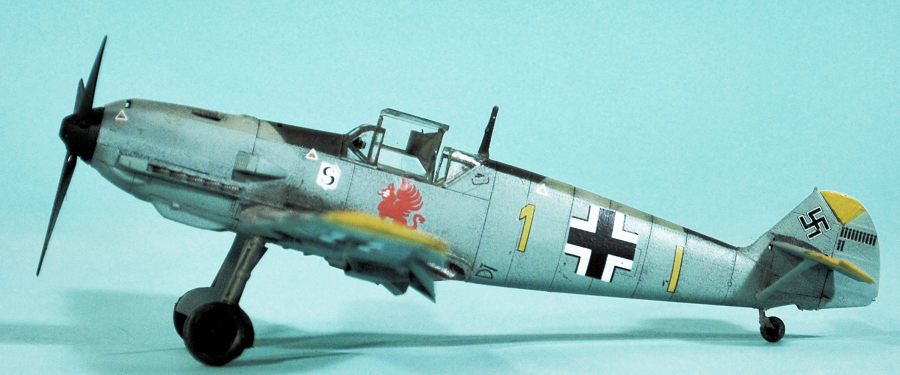
| KIT #: | 72439 |
| PRICE: | $21.95 |
| DECALS: | Four options |
| REVIEWER: | Tom Cleaver |
| NOTES: |
2020 release |

| HISTORY |
The Bf-109E was the first of the series to have a performance equal to or better than the best extant fighters in Europe, thanks to use of the DB 601 engine, the first German aero engine with more than 1,000 hp. First appearing in prototype form in 1938, the Bf-109E equipped all but a few Jagdgeschwadern by the outbreak of war on September 1, 1939.
While there was little opportunity to demonstrate the fighter’s capabilities before the end of the “Phoney War” and the beginning of the Blitzkrieg in western Europe on May 10, 1940, within a matter of days the pilots of the Bf-109E had clearly established air superiority over their opponents.
The Battle of Britain demonstrated the shortcomings of the fighter,
since it could only penetrate England as far as London, and had a maximum of 15
minutes’ combat time. A significant number of 109s were lost trying to get home
across the English Channel, and it was said that a 109 pilot fought with one eye
on the red fuel warning light. While the 109 had a clear speed advantage over
the Hurricane, and an altitude advantage over bo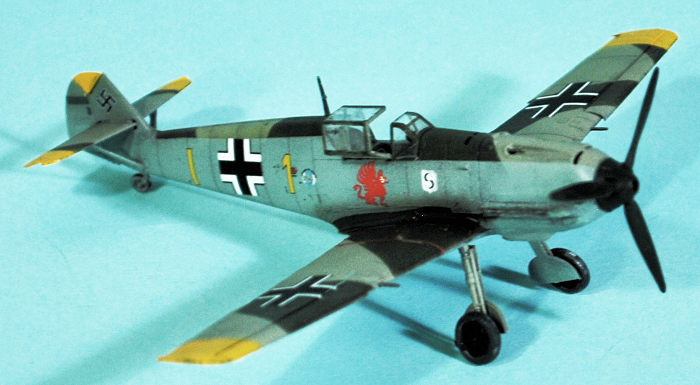 th Hurricane and Spitfire, in
addition to the ability to outmaneuver either to get away with its direct fuel
injection system as opposed to the carburetor used by the Merlin, it had worse
cockpit visibility than either opponent, a situation made worse with the
adoption of more extensive pilot head armor beginning with the Bf-109E-4 that
appeared in August 1940. While the Bf-109E-7 had the capability of carrying a 66
Imperial Gallon drop tank and appeared in combat by the end of August 1940, the
fighter units involved in the Battle of Britain did not make use of this new
capability, which could have completely changed the nature of the air war over
southern England.
th Hurricane and Spitfire, in
addition to the ability to outmaneuver either to get away with its direct fuel
injection system as opposed to the carburetor used by the Merlin, it had worse
cockpit visibility than either opponent, a situation made worse with the
adoption of more extensive pilot head armor beginning with the Bf-109E-4 that
appeared in August 1940. While the Bf-109E-7 had the capability of carrying a 66
Imperial Gallon drop tank and appeared in combat by the end of August 1940, the
fighter units involved in the Battle of Britain did not make use of this new
capability, which could have completely changed the nature of the air war over
southern England.
With the expansion of the war into southeastern Europe and the Mediterranean in 1941, the Bf-109E appeared on those fronts. The twelve fighters of 7th Staffel of JG 26, sent to Siciliy in February 1941, quickly established air superiority over their RAF opponents in combat over Malta during the next two months. The fighter also appeared in the Western Desert with the arrival of JG 27 that May, to provide air support to the Afrika Korps.
Replacement of the Bf-109E series by the Friedrich (Bf-109F) began in late 1940 and was complete on the Western Front by the summer of 1941. The Emil did not disappear from front line service on the Eastern Front until 1942, though it was used primarily as a fighter-bomber by the fall of 1941.
| THE KIT |
While there have always been 1/72 kits of the Bf-109E available since the first release of an Emil by Revell in the mid-1960s, Special Hobby’s announcement last fall of a completely newly-designed 1/72 kit done in cooperation with Eduard marked the first time a kit in 1/72 included posable flaps, slats, and other control surfaces, as has become de rigeur with Emil kits in 1/48 since the first appearance of the Hasegawa series in the late 1980s.
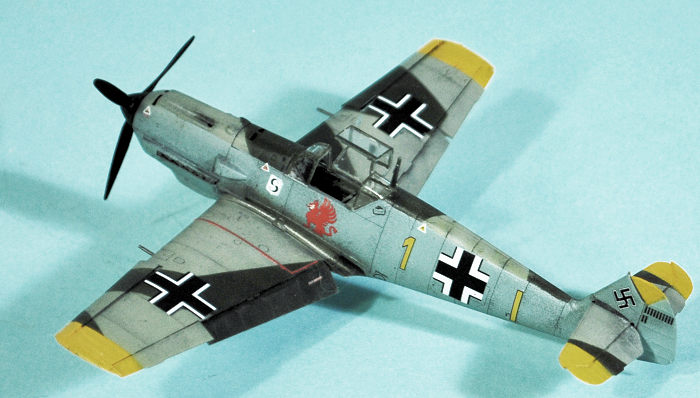 Opening the box, one is immediately struck by the high quality of the
kit design and its execution in plastic. Surface detail includes rivets that are
approximately scale-appropriate in look, while the fabric-covered flaps,
ailerons, elevators and rudder are done with restraint. While the cockpit is not
as detailed as a 1/48 kit, it is far more detailed than previous Emil kits in
1/72, and the result looks quite acceptable. Decals are provided for four
different 109Es in interesting markings and camouflage patterns.
Opening the box, one is immediately struck by the high quality of the
kit design and its execution in plastic. Surface detail includes rivets that are
approximately scale-appropriate in look, while the fabric-covered flaps,
ailerons, elevators and rudder are done with restraint. While the cockpit is not
as detailed as a 1/48 kit, it is far more detailed than previous Emil kits in
1/72, and the result looks quite acceptable. Decals are provided for four
different 109Es in interesting markings and camouflage patterns.
Overall, the kit is certainly on the same level regarding detail and accuracy as the new Arma Hobby Hurricanes, FM-2 and Yak-1, as well as any of Eduard’s 1/72 offerings. If you think of it as Eduard’s Bf-109E series, shrunk down to 1/48, you’ll have a good idea of what’s there.
| CONSTRUCTION |
The kit is simple enough in design that one can consider it a “slammer.” That’s a good thing!
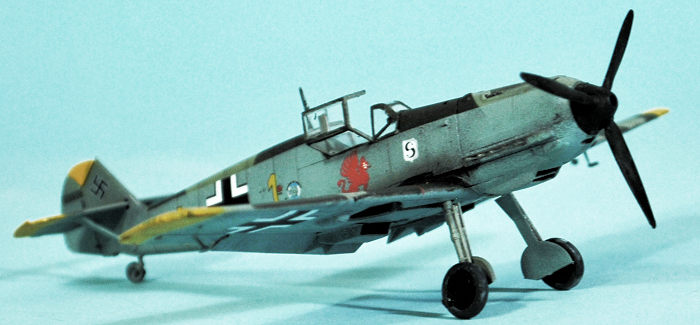 Cockpit detail is molded on the sidewall interiors of the fuselage
halves, which is perfectly fine in this scale. A photo-etch instrument panel
with an acetate “sandwich” takes care of that detail, while photoetched seat
belts complete the detail. I painted everything in the cockpit while the parts
were still on the sprue.
Cockpit detail is molded on the sidewall interiors of the fuselage
halves, which is perfectly fine in this scale. A photo-etch instrument panel
with an acetate “sandwich” takes care of that detail, while photoetched seat
belts complete the detail. I painted everything in the cockpit while the parts
were still on the sprue.
Assembly is easy; this is a kit that wants to go together. With care, there is no need for filler of any kind. The wing once assembled will “click” into position when mated to the fuselage. The elevators are molded on to the horizontal stabilizers in the neutral position, but it is not at all difficult to cut them free and pose them drooped if you have a mind to do that. I had the kit together over a few hours of 20-30-minute breaks from writing the new book.
| COLORS & MARKINGS |
I decided to do the JG 26 airplane flown by JG 26 experte Gerhard Schöpfel during the Battle of Britain. I picked this option since it is commonly considered that Schöpfel shot down Josef Frantisek, whose Hurricane was the option I did with the Arma Hobby kit. Thus the two models make for a “dogfight double.”
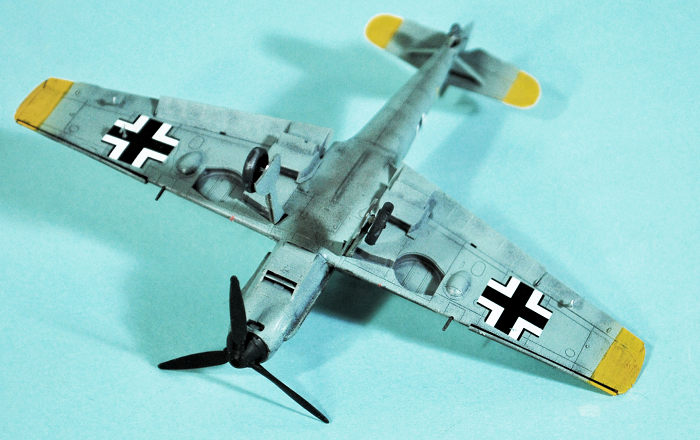 In 1/72, it’s a good idea to mask off the various colors, since it isn’t
possible to get an acceptable color demarcation painting freehand with most
airbrushes. I used Tamiya XF-23 “Light blue,” which is a perfect match for RLM
65 Hellblau, Tamiya XF-61 “Dark Green,” which is RLM 71 Dunkelgrun, and Tamiy
XF-22 “RLM Grey” for RLM 02 Graugrun, lightened with 30% XF-2 Flat white. I then
gave the model an overall coat of Micro Gloss.
In 1/72, it’s a good idea to mask off the various colors, since it isn’t
possible to get an acceptable color demarcation painting freehand with most
airbrushes. I used Tamiya XF-23 “Light blue,” which is a perfect match for RLM
65 Hellblau, Tamiya XF-61 “Dark Green,” which is RLM 71 Dunkelgrun, and Tamiy
XF-22 “RLM Grey” for RLM 02 Graugrun, lightened with 30% XF-2 Flat white. I then
gave the model an overall coat of Micro Gloss.
I used the kit decals, which went on without problem. I did not, however, do a complete take on the stencils, since these are “scale” in size and small enough that most are hard to see even if applied right. When finished, the model was given a coat of Micro Flat.
I applied exhaust staining with Tamiya “Smoke.” I unmasked the canopy and posed it in the open position. While it had looked a little thick during assembly, it looks “close enough” when posed like this. I assembled the landing gear and attached it, and the prop. At that point I called it done.
| CONCLUSIONS |
This is the most detailed 1/72 Bf-109E in existence. It is an easy kit to assemble that presents no problems and “wants to be built.” This kit and the Arma Hobby kits are a great argument in favor of adding 1/72 models to your repertoire. Thanks to my government-paid, bureaucrat-run health care (the VA) I have my eyes back and can see models this small again.
21 January 2021
Copyright ModelingMadness.com. All rights reserved.
This kit provided by Special Hobby
If you would like your product reviewed fairly and fairly quickly, please contact the editor or see other details in the Note to Contributors.
Back to the Main Page Back to the Review Index Page Back to the Previews Index Page